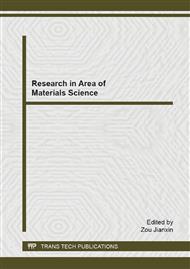[1]
M. Pantoja, M. A. Martınez, J. Abenojar, Effect of EtOH/H2O ratio and pH on bis-sulfur silane solutions for electrogalvanized steel joints based on anaerobic adhesives, J. Adhesion, 87 (2011) 688–708.
DOI: 10.1080/00218464.2011.596771
Google Scholar
[2]
Xiaochao Xian, Minglu Chen, Lixin Li, Key factors influencing the stability of silane solution during long-term surface treatment on carbon steel, J. Corrosion Science, 74 (2013) 283–289.
DOI: 10.1016/j.corsci.2013.04.055
Google Scholar
[3]
S. P. Kotha, M. Lieberman, Adhesion enhancement of steel fibers to acrylic bone cement through a silane coupling agent, J. Wiley InterScience, (2005) 112-118.
DOI: 10.1002/jbm.a.30543
Google Scholar
[4]
Danqing Zhu, Wim J. van Ooij, Corrosion protection of metals by water-based silane mixtures of bis-[trimethoxysilylpropyl]amine and vinyltriacetoxysilane, J. Progress in Organic Coatings, 49 (2004) 42–53.
DOI: 10.1016/j.porgcoat.2003.08.009
Google Scholar
[5]
Jun Song, W. J. van Ooij, Bonding and corrosion protection mechanisms of γ-APS and BTSE silane films on aluminum substrates, J. Adhesion Science and Technology, 17 (16) (2003) 2191–2221.
DOI: 10.1163/156856103772150788
Google Scholar
[6]
Dingchuan Xue, William J. Van Ooij, Corrosion performance improvement of hot-dipped galvanized (HDG) steels by electro-deposition of epoxy-resin-ester modified bis-[tri-ethoxy-silyl] ethane (BTSE) coatings, J. Progress in Organic Coatings, 76 (2013).
DOI: 10.1016/j.porgcoat.2013.03.004
Google Scholar
[7]
Paula Puomi, Heidi M. Fagerholm, Characterization of hot-dip galvanized (HDG) steel treated with bis-1, 2-(triethoxysilyl)ethane and γ-aminopropyltriethoxysilane, J. Adhesion Science and Technology, 15 (8) (2001) 869–888.
DOI: 10.1163/15685610152542342
Google Scholar
[8]
Jyongsik Jang, Eui Kyoon Kim, Corrosion protection of epoxy-coated steel using different silane coupling agents, J. Journal of Applied Polymer Science, 71 (1999) 585–593.
DOI: 10.1002/(sici)1097-4628(19990124)71:4<585::aid-app10>3.0.co;2-d
Google Scholar


